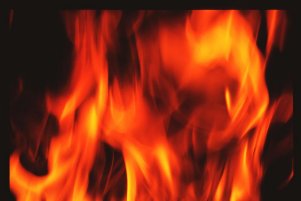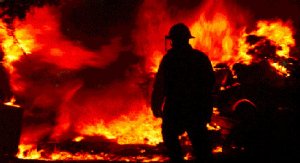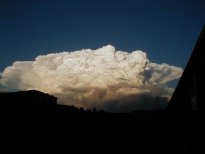Fire Basics
Physics and Chemistry of Fire
Fire Triangle
There are three main components to the fire triangle as shown in Figure 1 below. These components
are fuel, heat, and oxygen. Without at least these three components,
fire cannot exist.

Figure 1: Fire Triangle
Matter States
Matter exists in three basic states: solid, liquid, or gas. A substance
experiences a phase change when the physical characteristics of that
substance change from one state to another state. Perhaps the most recognizable examples of
phase changes are those changes from a solid to a liquid or a liquid to
a gas. When a substance goes through a phase change, there is a change
in the internal energy of the substance but not the temperature of the
substance (Serway, et al. 611).
Combustion
Combustion is a rapid, continuous reaction that usually takes place in the
gas phase. Wood is an organic compound primarily comprised of cellulose. For
wood, the phase change from a solid to gas is almost instantaneous as combustion
occurs (Coleman, et al. 95). Ignition occurs when an outside source is no longer
needed to sustain combustion (Coleman, et al. 87).

Photo Courtesy of WildlandFire.com
Heat
Heat is a physical characteristic of energy that is produced as energy
changes form. It is characterized by the transfer of energy resulting
from a difference in temperature between a system and its surroundings (Serway, et al. 605).
Energy cannot be created or destroyed; it only changes form. There are
several sources of heat. These sources are chemical, mechanical, electrical, and nuclear.
- Chemical
- The most common source of heat for the purpose of
firefighting comes from chemical reactions. When something burns,
it is the result of a chemical reaction where heat is being released.
Pyrolysis is the "decomposition or transformation of a compound caused
by heat."(Coleman, et al. 81)

Photo Courtesy of WildlandFire.com
- Mechanical
- The mechanical source of heat deals the heat that is
created from friction. Friction is a resistive force that occurs from the
rubbing or compression of materials. For firefighters, this source of
fire is seen mostly in industrial machinery (Coleman, et al. 81).
- Electrical
- An electric current exists when there is a net flow
of charge through a given area. Electrons flow from the negatively
charged region to the positively charged region. This is usually
accomplished by using an electrical conductor which allows the
electrons to pass freely through the material (Serway, et al. 709). This flow of electrons
can generate heat when collisions between the molecules and electrons occur.
These collisions then cause the molecules to break apart thus releasing
heat. Some common examples of electrical energy are lightning, static
electricity, and wiring outlets (Coleman, et al. 82). For the wildland
firefighter, lightning is probably the most common of electrical
sources of fire, if not one of the most dreaded during an extreme fire
season.

Photo Courtesy of WildlandFire.com
- Nuclear
- Probably the least common source firefighters will encounter
is nuclear energy. Nuclear energy deals with the breakdown of
radioactive materials. These reactions take place in a confined
environment where the release of heat or energy from the process
can be precisely controlled. In the event of a nuclear accident, little
can be done by firefights on scene. Rather efforts to evacuate the
surrounding area and minimize the exposed are pursued while
trained technicians handle the on-site emergency (Coleman, et al. 83).
Modes of Heat Transfer
- Conduction
- The transfer of heat through an object or material
is referred to as conduction (Coleman, et al. 92). Conduction will only occur if a difference in temperature
exists between the two sides of the conducting material (Serway, et al. 623).
Heat will travel from the hot source to the cold source.
- Convection
- Convection refers to the "energy transferred by the movement
of a warm substance (Serway, et al. 628)." As air is heated by a fire, it becomes less
dense and begins to rise above the cooler air surrounding it which is more
dense. This cooler air then begins to sink. This process will continue
until a new, equilibrium temperature has been reached. Convection resulting from the
changes of air density, such as above, is called natural convection (Serway, et al. 628).
An excellent example of natural convection is shown in the smoke plume below.

Photo Courtesy of WildlandFire.com
- Radiation
- Radiation is the continuous transmission of electromagnetic
waves which are caused by thermal variations between molecules. Every object
radiates energy in this manner. Stefan's Law, shown below in equation form, is a method used
to determine the rate at which this radiation occurs (Serway, et al. 628).
P=(5.669x10-8 W/m2*K4)AeT4
Where:
P = Power
A = Surface Area
e = emissivity
T = Surface Temperature in
Kelvin
Home|
Fire Basics|
Wildland Basics|
Fire Behavior|
Methods of Attack|
References
Heather Christian
fnhlc@uaf.edu
Phys 212x-SF05-General Physics II
Last update 03/17/2005





